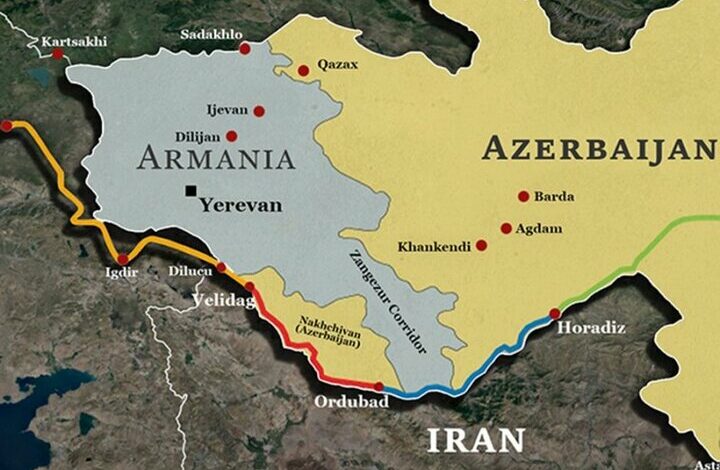Analyzing the Technical Dimensions of the Armenia-Azerbaijan Agreement: Ambiguities and Challenges

webangah News Agency, International Desk: Recently, many azerbaijani media outlets have portrayed the recent agreement signed in Washington between Ilham Aliyev and nikol Pashinyan-mediated by Donald Trump-as a historic achievement for establishing a new transportation route.
However, experts highlight numerous legal ambiguities and challenges embedded in this 17-article agreement between Azerbaijan and Armenia. The document cannot yet be seen as a finalized, durable, or guaranteed roadmap. Moreover, uncertainty extends beyond the text itself; points raised by Aliyev and Pashinyan about initiating a peace process also reveal ambiguities that serve as an entry point to broader challenges surrounding the Nakhchivan-Azerbaijan transit corridor.
Following Donald Trump’s typical media strategy, the signing was presented as evidence of his international leadership role. The farcical suggestion of awarding him a Nobel Peace Prize resurfaced amid this display.Yet many US and European analytical platforms acknowledge meaningful issues remain unresolved within the deal.
Such as, geopolitical analysts at Oxford Analytica warn that “challenges related to amending Armenia’s constitution, undefined customs mechanisms, and ambiguous Azerbaijani military presence along border areas” could derail progress toward reconciliation. The outlet also points to Iran’s critical stance: quoting Dr. Velayati, advisor to Iran’s Supreme Leader on this corridor issue-that while “Armenia has guaranteed that direct land connectivity with Iran remains intact,” Tehran fears wider strategic repercussions because it views this corridor as “a tool for expanding US and Israeli influence in the region.”
Certain Armenian politicians and critics oppose the plan vehemently. Murad Papazyan expressed doubts over customs supervision and border control protocols stating: “This is a serious violation of our national sovereignty. The entire process favors Azerbaijan and turkey while weakening Armenia.” Similarly, Quincy Institute characterizes it as an “ambiguous fragile draft” unwilling to clarify critical questions regarding American involvement levels.
Three Key Challenges Highlighted in a Brief Joint Statement
The joint statement from Aliyev and pashinyan contains notable points worth scrutiny:
1. A shared request from armenian and Azerbaijani foreign ministers urging OSCE (Organization for Security & cooperation in Europe) to suspend or terminate Minsk process mechanisms presents major hurdles due to OSCE’s 57-member states’ diverse interests; some members may oppose ending Minsk talks-for instance Kazakhstan’s Central Asian neighbors Tajikistan, Turkmenistan, Uzbekistan might view halting Minsk processes contrary to their geopolitical goals vis-à-vis Russia or Europe.
2. Another clause refers explicitly: “Reopening communications between both countries for domestic transport-including unobstructed connection between mainland Azerbaijan & it’s Nakhchivan Autonomous Republic through Armenian territory with mutual benefits.” Terms like “unobstructed” traveling alongside “mutual benefits” are vague formulations prone to differing interpretations complicating implementation.
3. An additional unclear provision states: “Armenia will cooperate with the United States of America and third parties to establish frameworks for realizing TRIPP-the Trump Route Project Promoting Peace & Prosperity-within Armenian territory.” Here terms defining scope or limits of Armenia’s obligations towards cooperation with Washington remain unspecified.
The above three issues mirror deeper technical execution uncertainties embedded throughout this 17-article document.
Main Challenges And ambiguities Within The 17-Article Agreement
The core issue concerns sovereignty rights over the transit corridor itself.Financial Times highlights how despite Armenian legal sovereignty per agreement text-“a 99-year lease grants America rights over progress/management including infrastructure such as railways roads energy networks telecommunications”-operative arrangements on security responsibilities remain unclear; specifically weather protective duties fall upon Armenian personnel/private contractors or foreign forces remains undetermined.
Apart from security questions there is no clarity on vital technical matters such as customs control procedures including passport inspections along corridors-is there any permanent presence by Armenian forces? Or will their role be merely symbolic? Such gray-area clauses raise concerns about whether practical control effectively transfers from Armenia onto American hands under contractual arrangements described ambiguously here.
This Uncertainty Extends To Amendments To The Constitution
An outstanding ambiguity surrounds proposed changes required within Armenia’s constitutional text currently conflicting with existing arrangement commitments-expected revisions would remove references relating directly to Nagorno-Karabakh based on Baku’s demands but timing challenges arise given elections scheduled before 2026 complicating Prime Minister Pashinyan’s prospects-and resistance voiced by opposition parties foreshadows difficulties implementing these plans (as noted by washington Post).
This question recalls Article 2 affirming both sides pledge no territorial claims now or future-which contrasts Article 6 mandating negotiations per agreed commissions tasked with delineation/demarcation borders precisely-and intensifies when Article 13 proclaims neither party may cite domestic legislation excuses against fulfilling terms whereas Article 16 declares enforceability dependent upon harmonization with national laws respectively.u00a0
Ultimately operational uncertainties combined with strategic fragility permeate all sections without clear protocols regarding tariffs revenue sharing oversight bodies governing usage-all indicating that rather than fostering regional stability this corridor appears primarily designed serving geopolitical ambitions linked directly both personally around former US President Trump alongside broader American interests strategizing influence projections across South Caucasus region.
}


